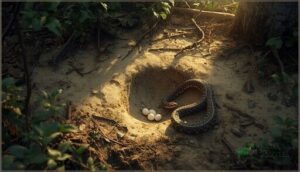This site is supported by our readers. We may earn a commission, at no cost to you, if you purchase through links.
Tucked beneath logs, buried in leaf litter, or hidden deep in burrows, snake eggs are quietly transforming—sometimes by the hundreds, sometimes just one. A python can fill a nest with more than 100 eggs, while a tiny threadsnake may lay only a single, delicate shell.
What decides how many eggs hit the earth, and how many hatchlings actually wriggle free, depends on a tangle of age, environment, and luck. When you start to look closer, you’ll find that snake egg survival isn’t a simple numbers game; it’s shaped by a world of changing risks and fascinating strategies.
Table Of Contents
- Key Takeaways
- How Many Eggs Do Snakes Lay?
- Factors Influencing Snake Egg Production
- Where and How Do Snakes Lay Eggs?
- How Many Snake Eggs Survive to Hatching?
- What Happens After Hatching?
- Conservation and Survival Challenges for Snake Eggs
- Frequently Asked Questions (FAQs)
- How many eggs can 1 snake lay?
- How many babies do snakes have at once?
- How long do baby snakes stay with their mother?
- Do snakes lay eggs or have live births?
- How do snake eggs differ from bird eggs?
- Can snakes lay unfertilized eggs like chickens?
- Do male snakes play any role after mating?
- How long can snake eggs survive without incubation?
- Are snake eggs edible for humans?
- Can snakes lay eggs more than once a year?
- Conclusion
Key Takeaways
- Snake species lay a wide range of eggs per clutch, from as few as one to more than 100, with pythons and mud snakes among the biggest egg producers.
- The number of eggs and their survival depends on the mother’s age and health, local temperature and humidity, nest site, and risk from predators.
- Most mother snakes lay their eggs and leave, but a few species, like pythons, guard and incubate their clutches to boost survival.
- In the wild, many eggs don’t hatch—hatch rates can be as low as 5% to 50% because of predators, harsh weather, and habitat loss.
How Many Eggs Do Snakes Lay?
The number of eggs a snake lays depends heavily on its species, with some producing just a handful while others lay over a hundred in a single clutch.
You’ll find that most egg-laying snakes fall somewhere in the middle, with clutch sizes reflecting their size, habitat, and evolutionary strategy.
Let’s look at how different species compare, from the smallest clutches to the record-holders.
Average Clutch Size by Species
Clutch size varies wildly across oviparous snake species. You’ll find threadsnake singularities with just one egg per clutch, while pythons push the extremes with 30 to 50 eggs—sometimes hitting 100. Mud snake records show remarkable variance, ranging from 4 to 111 eggs.
The mean clutch estimation across species sits around 12 eggs, though individual hatchlings face very different odds depending on their parents’ species. Snake egg clutches can vary markedly in weight, with some weighing several pounds.
Species That Lay The Most Eggs
When you’re looking at record-holders, reticulated pythons and Burmese pythons dominate the charts. Reticulated pythons can exceed 100 eggs per clutch in captivity, while invasive Burmese pythons in Florida have reached 96 eggs—nearly double their typical output.
Eastern mud snakes aren’t far behind, with one documented clutch of 111 eggs.
King cobras, the largest venomous oviparous snake species, produce 20 to 50 eggs per breeding season.
Smallest and Largest Clutch Examples
At the opposite end, you’ll find threadsnakes that lay just one egg per clutch, while crown snakes average around three. Some tropical colubrids produce only two to five eggs, trading clutch size for larger offspring.
Meanwhile, those massive reticulated python clutches can weigh 30 to 60 pounds—that’s serious reproductive investment. The largest clutch recorded for Burmese pythons in Florida was 87 eggs.
These clutch size extremes reflect how different species balance egg count against hatchling survival strategies.
Factors Influencing Snake Egg Production
Not every female snake lays the same number of eggs, and several factors determine how large or small her clutch will be. A snake’s age, health, and environment all play a role in reproduction.
Understanding what influences egg production helps you appreciate the natural variation you’ll see across different species and situations.
Maternal Age and Health
You mightn’t think a snake’s age matters much, but older, larger females can lay anywhere from 5 to 21 eggs per clutch—considerably more than younger snakes.
Maternal experience and body condition directly impact egg viability and hatchling health. Healthier mothers produce bigger, more hearty eggs, boosting survival rates and reproductive timing.
It’s a critical piece of snake reproductive biology and reptilian reproduction.
Environmental Conditions (Temperature, Humidity)
Regarding snake eggs, temperature extremes and humidity fluctuations can make or break the clutch. A nest microclimate that’s too hot raises embryo failure, while poor moisture invites desiccation risk or even microbial invasion.
Stable environmental factors are key—steady temps and humidity help control clutch size, incubation period, and ultimately, snake eggs survival for many species.
Nutritional Status and Stress
When Maternal Nutrition is at its best, you’ll see bigger clutch size, firmer shells, and higher Clutch Viability—think of it as a mother snake stacking the deck for snake eggs survival. But when Stress Hormones are high, or nutrition falters, hatchling fitness drops fast.
Combined Effects of poor diet and stress can cut reproductive output in half—a stark lesson in reptile ecology and behavior.
Where and How Do Snakes Lay Eggs?
When it’s time for a snake to lay her eggs, picking the right spot makes all the difference. You’ll find that snakes have their own favorite places and ways to keep their eggs safe.
Let’s look at how these choices play out in the wild.
Preferred Nesting Sites
Ever wonder where a snake chooses to lay its eggs? Female snakes show impressive nest fidelity, often returning to the same spots, favoring well-drained sandy soils or abandoned burrows. Substrate preference plays a big role—thermal cues guide them to sites that help eggs incubate safely.
Habitat disturbance, though, can limit options, making clutch size and incubation period more unpredictable.
Egg Characteristics and Protection
Snake eggs are remarkable little fortresses. Each one sports a flexible shell—mostly keratin and collagen—with multi-layered defenses that keep developing youngsters safer from drying out and hungry predators. Some shells even have natural antimicrobials and blend seamlessly into their nest, turning camouflaged clutch sites into invisible treasure troves.
Snake eggs are flexible, fortified shells layered with hidden defenses that protect developing young from dryness, predators, and disease
- Feel the tough resilience beneath gentle shells.
- Imagine invisible defenses at work.
- Picture every egg working to beat the odds.
Maternal Care Vs. Abandonment
You might be surprised: caring mothers are rare in snake eggs. Across most species, females lay their clutch, then leave—this is the abandonment standard.
However, a few, like pythons from Africa and Asia, showcase Care Evolution—guarding clutches and incubating eggs. This Python Behavior gives clear Guarding Benefits but remains tied to specific environments and Geographic Patterns.
How Many Snake Eggs Survive to Hatching?
Not every snake egg makes it safely to hatching. There are plenty of challenges along the way, from hungry predators to unpredictable weather.
Here are a few key factors that can shape how many eggs finally hatch.
Typical Hatch Rates in The Wild
Did you know most wild snake nests don’t see every egg hatch? Nest Success Rates can swing from as low as 5% in rough years to 50% or higher with good conditions. Here’s what shapes hatchling survival:
- Environmental Disturbances
- Clutch size and placement
- Predator Impact
- Conservation Strategies
These factors make egg laying in snake ecology a real balancing act.
Predation and Natural Threats
Think wild eggs have it tough? Egg predators like raccoons, skunks, and even other snakes keep survival rates low, often below 20%. Regional influences matter—a nest near the woods faces different risks than one by a field.
Smart nesting behaviors help, but habitat destruction hands predators the upper hand, making clutch size and hatchling success a roll of the dice.
Impact of Environmental Factors on Survival
Besides hungry predators, environmental factors often tip the scales for hatchling success. Temperature effects and humidity risks shape whether a clutch stands a chance. Extreme weather and climate instability can wipe out whole nests overnight.
Nesting microhabitats, from shaded leaf litter to burrows, help buffer eggs. But as habitat destruction spreads, the delicate balance between reproduction and survival keeps growing harder to maintain.
What Happens After Hatching?
Once snake eggs hatch, the young are left to face the world on their own. This is when things really get interesting—and risky—for each hatchling.
Here’s what they’re up against just after breaking free from the egg.
Hatchling Vulnerability and Predation
Even after hatching, snake hatchlings face steep odds. Post-hatching mortality often peaks in the first 48 hours, as environmental vulnerability and predator attack patterns—like midday raids from raccoons or fire ants—take a heavy toll.
Anti-predator adaptations, such as death-feigning, can help, but adult snake impact around dens and clutch size both shape the risks hatchlings face.
Survival Rates to Adulthood
The journey from hatchling to adult snake is a steep climb, with juvenile survival rates often dipping as low as 30% in the wild. Adult longevity factors—like stable habitat and fewer predators—help boost survival after five years.
Captive vs. wild comparisons show captivity eases many environmental stressors, but wild-born snakes shape population age structure, supporting ongoing wildlife conservation and species preservation.
Species Adaptations to Increase Survival
Once hatchlings emerge, you’ll notice nature’s bag of tricks at play—Shell Permeability keeps eggs safe from drying out, while clever Nesting Strategies, like underground sites, cut down on Predation.
Some mothers show Maternal Defense, guarding young. Hatching Synchrony swamps predators, Camouflage Toxins deter threats, and varied Clutch Size lets snakes hedge bets against shifting Environmental Factors, maintaining Ecological Balance through Evolutionary Adaptations.
Conservation and Survival Challenges for Snake Eggs
Keeping snake eggs safe isn’t as simple as it sounds, especially with all the challenges they face today. From changes in their natural habitat to risks brought on by people, lots of factors can make survival tough.
Up next, you’ll see some common ways to help give these eggs a better chance.
Habitat Loss and Human Impact
Imagine losing your favorite hiding spot every year—that’s what snakes face as habitat fragmentation and urban encroachment take over forests. Habitat destruction leads to fewer safe nesting sites.
With deforestation effects and chemical exposure, snake eggs experience higher predation and lower hatching success.
All of this throws ecological balance off and highlights the environmental impact on species like snakes.
Importance of Conservation Efforts
If you value healthy ecosystems, you’ll understand why conservation actions for snake eggs go beyond just protecting nests. These efforts help:
- Maintain genetic diversity
- Support population stability
- Boost ecosystem health
- Lessen threats through habitat reserves
- Strengthen wildlife conservation education
Effective conservation biology keeps species resilient and bolsters biodiversity protection for the long run.
Strategies to Improve Egg and Hatchling Survival
To boost snake egg and hatchling survival, you want to focus on smart Predator Deterrence such as egg burial, reliable Incubation Conditions, and gentle Safe Handling.
Environmental Management with steady humidity and temperature is key, while Conservation Interventions—like fencing or habitat restoration—also make a big difference.
Solid Snake Egg Care all along the incubation period means more hatchlings thrive.
Frequently Asked Questions (FAQs)
How many eggs can 1 snake lay?
Think of each snake species as a different kind of storyteller; some, like the Eastern Mud Snake, set records with clutch sizes up to 111 eggs, while others—such as ball pythons—quietly lay just 3 to 11 per clutch.
How many babies do snakes have at once?
Clutch size variation is wide in snakes—some oviparous species lay from 3 up to over 100 eggs, while live birth numbers can reach 40 hatchlings.
Factors like multiple clutches annually, sperm storage, and offspring size variation shape these counts.
How long do baby snakes stay with their mother?
Most baby snakes show brief maternal association, staying with their mother from a few hours up to two weeks.
Species variation is key—rattlesnakes and pythons display protective behaviors, while most hatchlings disperse independently soon after egg incubation.
Do snakes lay eggs or have live births?
Snakes show striking diversity: about 70% are oviparous, laying snake eggs (Oviparity Explained), while others are viviparous or ovoviviparous (Viviparity Defined, Ovoviviparity Traits), giving birth to live hatchlings.
Each strategy offers evolutionary advantages across species examples.
How do snake eggs differ from bird eggs?
Unlike bird eggs, snake eggs have soft, leathery shells and absorb moisture from their environment.
Their incubation methods rely on external warmth, and parental care is minimal.
Egg shape is oblong, aiding oviparous development and successful hatchlings.
Can snakes lay unfertilized eggs like chickens?
As the saying goes, “Nature finds a way.” Snakes can lay unfertilized eggs, known as slugs. These rarely hatch, but in some species, parthenogenesis leads to viable offspring—basically genetic cloning—though this occurs infrequently.
Do male snakes play any role after mating?
After the mating process, male snakes show complete paternal absence. Their post-mating behavior is driven by evolutionary reasons—mating competition takes priority.
Males leave immediately, offering no care or protection, which is a consistent snake reproduction method across species.
How long can snake eggs survive without incubation?
If you ever find snake eggs left alone, remember their Viability Timeframe is short—just 2 to 3 days without proper incubation.
Temperature Impact and Humidity Needs matter most, with Species Variation and Clutch Condition affecting survival.
Are snake eggs edible for humans?
Yes, snake eggs are edible for humans, but there are important considerations to keep in mind. These include Culinary Uses, Nutritional Value, Health Risks, Legal Aspects, and Ethical Concerns.
Always cook thoroughly and check for local rules before trying eggs from any snake species.
Can snakes lay eggs more than once a year?
It might seem like snakes are laying eggs nonstop, but most follow strict reproductive cycles, producing only one clutch of snake eggs yearly.
Environmental triggers and physiological limits keep clutch frequency low, though rare viviparous exceptions exist in snake reproduction.
Conclusion
Picture a single snake mother juggling a mountain of challenges—dodging predators, battling the weather, timing everything just right. When you ask, “how many eggs do snakes lay and how many survive?,” the answer spins between luck and survival smarts.
Sometimes, most eggs never hatch; other times, dozens become tiny wanderers. Each egg is a gamble, shaped by the rhythms of nature and the odds of the wild, making every new snake a tiny miracle in itself.
- https://www.facebook.com/groups/kansascreeking/posts/1952612521502266/
- https://vettoday.com/blog/pet-health/snake-reproduction/
- https://a-z-animals.com/animals/snake/snake-facts/snake-eggs/
- https://www.thecritterdepot.com/blogs/news/how-many-eggs-do-ball-pythons-lay
- https://journals.plos.org/plosone/article?id=10.1371%2Fjournal.pone.0141460














